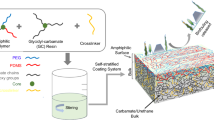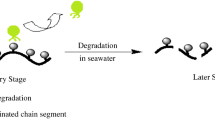Abstract
Amphiphilic siloxane–polyurethane (AmSiPU) coatings were prepared using a series of polyisocyanate prepolymers modified with polydimethyl siloxane (PDMS) and poly(ethylene glycol) (PEG). Fouling-release performance of the AmSiPU coatings was evaluated through laboratory biological assays using several representative marine organisms. First, polyisocyanate prepolymers with compositional variation in PDMS and PEG were synthesized and characterized using Fourier transform infrared spectroscopy (FTIR) and isocyanate titrations. Then, the prepolymers were incorporated into coatings. Surface wettability of the coatings was evaluated using contact angle and surface energy measurements. Coatings’ surfaces were also characterized using attenuated total reflectance Fourier transform infrared spectroscopy (ATR-FTIR), X-ray photoelectron spectroscopy (XPS), and atomic force microscopy (AFM). ATR-FTIR and XPS experiments revealed that both PDMS and PEG moieties were present on the surface suggesting amphiphilic character. AFM phase images show microphase separation. AmSiPU coatings show excellent fouling-release performance toward bacteria (Cellulophaga lytica), the diatoms (Navicula incerta), and the green algae (Ulva linza), demonstrating comparable or superior performance to many commercial amphiphilic fouling-release coatings. Despite the incorporation of hydrophilic PEG, AmSiPU coatings show good macrofouling release which is often challenging with amphiphilic coating systems. AmSiPU coatings are a nontoxic and tough fouling-release solution with comparable performance to benchmarks in the fouling-release coatings market.













Similar content being viewed by others
References
Yebra, DM, Kiil, SK, Dam-Johansen, K, “Antifouling Technology—Past, Present and Future Steps Towards Efficient and Environmentally Friendly Antifouling Coatings.” Prog. Org. Coat., 50 (2) 75–104 (2004)
Hellio, C, Yebra, DM, Advances in Marine Antifouling Coatings and Technologies. Woodhead Publishing Limited, Cambridge (2009)
Lejars, M, Margaillan, A, Bressy, C, “Fouling Release Coatings: A Nontoxic Alternative to Biocidal Antifouling Coatings.” Chem. Rev., 112 (8) 4347–4390 (2012)
Nurioglu, AG, Esteves, ACC, de With, G, “Non-toxic, Non-biocide-Release Antifouling Coatings Based on Molecular Structure Design for Marine Applications.” J. Mater. Chem. B, 3 (32) 6547–6570 (2015)
Callow, JA, Callow, ME, “Trends in the Development of Environmentally Friendly Fouling-Resistant Marine Coatings.” Nat. Commun., 2 244 (2011)
Magin, CM, Cooper, SP, Brennan, AB, “Non-toxic Antifouling Strategies.” Mater. Today, 13 (4) 36–44 (2010)
Schultz, MP, Bendick, JA, Holm, ER, Hertel, WM, “Economic Impact of Biofouling on a Naval Surface Ship.” Biofouling, 27 (1) 87–98 (2011)
Callow, ME, Callow, JA, “Marine Biofouling: A Sticky Problem.” Biologist, 49 (1) 10 (2002)
Konstantinou, IK, Albanis, TA, “Worldwide Occurrence and Effects of Antifouling Paint Booster Biocides in the Aquatic Environment: A Review.” Environ. Int., 30 (2) 235–248 (2004)
Majumdar, PM, Ekin, A, Webster, DC, “Thermoset Siloxane—Urethane Fouling Release Coatings.”ACS Symp. Ser., 957 (Smart Coatings) 61–75 (2007)
Webster, DC, Ekin, A, “Functionalized Polysiloxane Polymers.” US 7799434 B2 (2010)
Webster, DC, Pieper, RJ, Ekin, A, “Thermoset Siloxane–Urethane Fouling Release Coatings.” US 7989074 B2 (2011)
Ekin, A, Webster, DC, “Combinatorial and High-Throughput Screening of the Effect of Siloxane Composition on the Surface Properties of Crosslinked Siloxane-Polyurethane Coatings.” J. Comb. Chem., 9 (1) 178–188 (2006)
Bodkhe, RB, Thompson, SEM, Yehle, C, Cilz, N, Daniels, J, Stafslien, SJ, Callow, ME, Callow, JA, Webster, DC, “The Effect of Formulation Variables on Fouling-Release Performance of Stratified Siloxane-Polyurethane Coatings.” J. Coat. Technol. Res., 9 (3) 235–249 (2012)
Sommer, S, Ekin, A, Webster, DC, Stafslien, SJ, Daniels, J, VanderWal, LJ, Thompson, SEM, Callow, ME, Callow, JA, “A Preliminary Study on the Properties and Fouling-Release Performance of Siloxane-Polyurethane Coatings Prepared from PDMS Macromers.” Biofouling, 26 (8) 961–972 (2010)
Iguerb, O, Poleunis, C, Mazéas, F, Compère, C, Bertrand, P, “Antifouling Properties of Poly(methyl methacrylate) Films Grafted with Poly(ethylene glycol) Monoacrylate Immersed in Seawater.” Langmuir, 24 (21) 12272–12281 (2008)
Wyszogrodzka, M, Haag, R, “Synthesis and Characterization of Glycerol Dendrons, Self-assembled Monolayers on Gold: A Detailed Study of Their Protein Resistance.” Biomacromolecules, 10 (5) 1043–1054 (2009)
Andrade, JD, King, RN, Gregonis, DE, Coleman, DL, “Surface Characterization of Poly(hydroxyethyl methacrylate) and Related Polymers. I. Contact Angle Methods in Water.” J. Polym. Sci. Polym. Symp., 66 (1) 313–336 (1979)
Heuberger, M, Drobek, T, Spencer, ND, “Interaction Forces and Morphology of a Protein-Resistant Poly(ethylene glycol) Layer.” Biophys. J ., 88 (1) 495–504 (2005)
Jeon, SI, Lee, JH, Andrade, JD, De Gennes, PG, “Protein–Surface Interactions in the Presence of Polyethylene Oxide.” J. Colloid Interface Sci., 142 (1) 149–158 (1991)
Szleifer, I, “Polymers and Proteins: Interactions at Interfaces.” Curr. Opin. Solid State Mater. Sci., 2 (3) 337–344 (1997)
Prime, KL, Whitesides, GM, “Adsorption of Proteins Onto Surfaces Containing End-Attached Oligo(ethylene oxide): A Model System Using Self-assembled Monolayers.” J. Am. Chem. Soc. , 115 (23) 10714–10721 (1993)
Sundaram, HS, Cho, Y, Dimitriou, MD, Weinman, CJ, Finlay, JA, Cone, G, Callow, ME, Callow, JA, Kramer, EJ, Ober, CK, “Fluorine-Free Mixed Amphiphilic Polymers Based on PDMS and PEG Side Chains for Fouling Release Applications.” Biofouling, 27 (6) 589–602 (2011)
Sundaram, HS, Cho, Y, Dimitriou, MD, Finlay, JA, Cone, G, Williams, S, Handlin, D, Gatto, J, Callow, ME, Callow, JA, Kramer, EJ, Ober, CK, “Fluorinated Amphiphilic Polymers and Their Blends for Fouling-Release Applications: The Benefits of a Triblock Copolymer Surface.” ACS Appl. Mater. Interfaces, 3 (9) 3366–3374 (2011)
Bodkhe, RB, Stafslien, SJ, Cilz, N, Daniels, J, Thompson, SEM, Callow, ME, Callow, JA, Webster, DC, “Polyurethanes with Amphiphilic Surfaces Made Using Telechelic Functional PDMS Having Orthogonal Acid Functional Groups.” Prog. Org. Coat., 75 (1–2) 38–48 (2012)
Martinelli, E, Sarvothaman, MK, Galli, G, Pettitt, ME, Callow, ME, Callow, JA, Conlan, SL, Clare, AS, Sugiharto, AB, Davies, C, Williams, D, “Poly(dimethyl siloxane) (PDMS) Network Blends of Amphiphilic Acrylic Copolymers with Poly(ethylene glycol)-Fluoroalkyl Side Chains for Fouling-Release Coatings. II. Laboratory Assays and Field Immersion Trials.” Biofouling, 28 (6) 571–582 (2012)
Imbesi, PM, Finlay, JA, Aldred, N, Eller, MJ, Felder, SE, Pollack, KA, Lonnecker, AT, Raymond, JE, Mackay, ME, Schweikert, EA, Clare, AS, Callow, JA, Callow, ME, Wooley, KL, “Targeted Surface Nanocomplexity: Two-Dimensional Control Over the Composition, Physical Properties and Anti-biofouling Performance of Hyperbranched Fluoropolymer-Poly(ethylene glycol) Amphiphilic Crosslinked Networks.” Polym. Chem., 3 (11) 3121–3131 (2012)
Stafslien, SJ, Christianson, D, Daniels, J, VanderWal, L, Chernykh, A, Chisholm, BJ, “Combinatorial Materials Research Applied to the Development of New Surface Coatings XVI: Fouling-Release Properties of Amphiphilic Polysiloxane Coatings.” Biofouling, 31 (2) 135–149 (2015)
Webster, DC, Bodkhe, RB, “Functionalized Silicones with Polyalkylene Oxide Side Chains.” US 9169359 B2 (2015)
Casse, F, Ribeiro, E, Ekin, A, Webster, DC, Callow, JA, Callow, ME, “Laboratory Screening of Coating Libraries for Algal Adhesion.” Biofouling, 23 (3/4) 267–276 (2007)
Cassé, F, Stafslien, SJ, Bahr, JA, Daniels, J, Finlay, JA, Callow, JA, Callow, ME, “Combinatorial Materials Research Applied to the Development of New Surface Coatings V. Application of a Spinning Water-Jet for the Semi-high Throughput Assessment of the Attachment Strength of Marine Fouling Algae.” Biofouling, 23 (2) 121–130 (2007)
Callow, ME, Callow, JA, Conlan, S, Clare, AS, Stafslien, S, “Efficacy Testing of Nonbiocidal and Fouling-Release Coatings.” In: Dobretsov, S, Thomason, JC, Williams, DN, (eds.) Biofouling Methods. Wiley, Oxford (2014). doi:10.1002/9781118336144.ch10
Stafslien, SJ, Bahr, JA, Daniels, JW, Wal, LV, Nevins, J, Smith, J, Schiele, K, Chisholm, B, “Combinatorial Materials Research Applied to the Development of New Surface Coatings VI: An Automated Spinning Water Jet Apparatus for the High-Throughput Characterization of Fouling-Release Marine Coatings.” Rev. Sci. Instrum., 78 (7) 072204 (2007)
Rittschof, D, Orihuela, B, Stafslien, S, Daniels, J, Christianson, D, Chisholm, B, Holm, E, “Barnacle Reattachment: A Tool for Studying Barnacle Adhesion.” Biofouling, 24 (1) 1–9 (2008)
Stafslien, S, Daniels, J, Bahr, J, Chisholm, B, Ekin, A, Webster, D, Orihuela, B, Rittschof, D, “An Improved Laboratory Reattachment Method for the Rapid Assessment of Adult Barnacle Adhesion Strength to Fouling-Release Marine Coatings.” J. Coat. Technol. Res., 9 (6) 651–665 (2012)
Owens, DK, Wendt, RC, “Estimation of the Surface Free Energy of Polymers.” J. Appl. Polym. Sci., 13 (8) 1741–1747 (1969)
Baier, RE, “Surface Behaviour of Biomaterials: The Theta Surface for Biocompatibility.” J. Mater. Sci. - Mater. Med., 17 (11) 1057–1062 (2006)
Louette, P, Bodino, F, Pireaux, J-J, “Poly(dimethyl siloxane) (PDMS) XPS Reference Core Level and Energy Loss Spectra.” Surf. Sci. Spectra, 12 (1) 38 (2005)
Mishra, AK, Chattopadhyay, DK, Sreedhar, B, Raju, KVSN, “FT-IR and XPS Studies of Polyurethane-Urea-Imide Coatings.” Prog. Org. Coat., 55 (3) 231–243 (2006)
Hearn, MJ, Ratner, BD, Briggs, D, “SIMS and XPS Studies of Polyurethane Surfaces. 1. Preliminary Studies.” Macromolecules, 21 (10) 2950–2959 (1988)
Majumdar, P, Lee, E, Patel, N, Ward, K, Stafslien, SJ, Daniels, J, Chisholm, BJ, Boudjouk, P, Callow, ME, Callow, JA, Thompson, SEM, “Combinatorial Materials Research Applied to the Development of New Surface Coatings IX: An Investigation of Novel Antifouling/Fouling-Release Coatings Containing Quaternary Ammonium Salt Groups.” Biofouling, 24 (3) 185–200 (2008)
Hoipkemeier-Wilson, L, Schumacher, JF, Carman, ML, Gibson, AL, Feinberg, AW, Callow, ME, Finlay, JA, Callow, JA, Brennan, AB, “Antifouling Potential of Lubricious, Micro-engineered, PDMS Elastomers Against Zoospores of the Green Fouling Alga Ulva (Enteromorpha).” Biofouling, 20 (1) 53–63 (2004)
Callow, ME, Callow, JA, Ista, LK, Coleman, SE, Nolasco, AC, Lopez, GP, “Use of Self Assembled Monolayers of Different Wettabilities to Study Surface Selection and Primary Adhesion Processes of Green Algae (Enteromorpha) Zoospores.” Appl. Environ. Microbiol., 66 (8) 3249–3254 (2000)
Finlay, JA, Callow, ME, Ista, LK, Lopez, GP, Callow, JA, “The Influence of Surface Wettability on the Adhesion Strength of Settled Spores of the Green Alga Enteromorpha and the Diatom Amphora.” Integr. Comp. Biol., 42 (6) 1116–1122 (2002)
Callow, JA, Callow, ME, Ista, LK, Lopez, G, Chaudhury, MK, “The Influence of Surface Energy on the Wetting Behavior of the Spore Adhesive of Marine Alga Ulva linza.” J. R. Soc. Interface, 2 319–325 (2005)
Holland, R, Dugdale, TM, Wetherbee, R, Brennan, AB, Finlay, JA, Callow, JA, Callow, ME, “Adhesion and Motility of Fouling Diatoms on a Silicone Elastomer.” Biofouling, 20 (6) 323–329 (2004)
Petrone, L, Di Fino, A, Aldred, N, Sukkaew, P, Ederth, T, Clare, AS, Liedberg, B, “Effects of Surface Charge and Gibbs Surface Energy on the Settlement Behaviour of Barnacle Cyprids (Balanus amphitrite).” Biofouling, 27 (9) 1043–1055 (2011)
Acknowledgments
The authors would like to acknowledge Office of Naval Research for financial support of this research under Grant Nos. N00014-12-1-0482, N00014-13-1-0633, and N00014-13-1-0634. The authors would also like to thank Kenneth Anderson at NDSU for his assistance with XPS experiments and Daniel Rittschof and Beatriz Orihuela at the Duke University Marine Laboratory for supplying adult barnacles and marine mussels for laboratory attachment and adhesion experiments.
Author information
Authors and Affiliations
Corresponding author
Additional information
This paper received the First Place Roon Award at the American Coatings Conference, April 11–13, 2016, in Indianapolis, IN.
Electronic supplementary material
Below is the link to the electronic supplementary material.
Rights and permissions
About this article
Cite this article
Galhenage, T.P., Webster, D.C., Moreira, A.M.S. et al. Poly(ethylene) glycol-modified, amphiphilic, siloxane–polyurethane coatings and their performance as fouling-release surfaces. J Coat Technol Res 14, 307–322 (2017). https://doi.org/10.1007/s11998-016-9862-9
Published:
Issue Date:
DOI: https://doi.org/10.1007/s11998-016-9862-9




